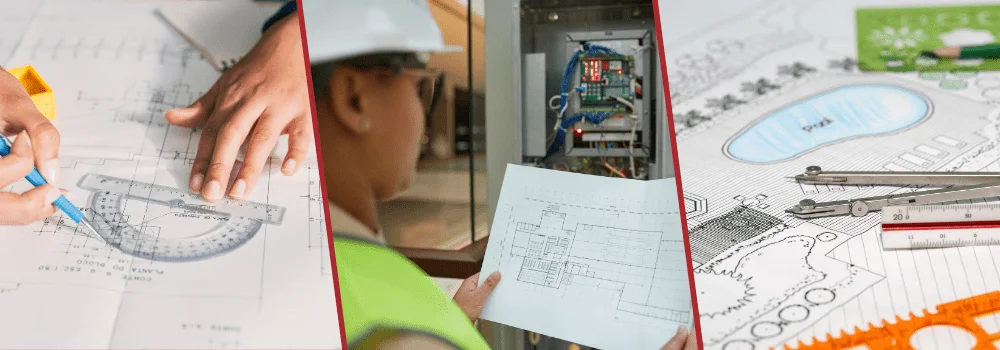How to Become an Electrical Drafter?
Learn how to become an electrical drafter with our comprehensive guide, including key steps, eligibility criteria, and career prospects

In this Career Outline

Introduction to Electrical Drafter
"An Electrical Drafter’s work is the blueprint of innovation, transforming complex concepts into clear, actionable designs." — Anonymous
Imagine being the mastermind behind the schematics that keep buildings running smoothly and safely. As an electrical drafter, you play a crucial role in designing the blueprints for electrical systems in everything from homes to high-rise buildings. With the growing complexity of modern construction and the increasing demand for efficient energy use, the need for skilled electrical drafters is higher than ever. Ready to light up your career? Here’s your roadmap to becoming an electrical drafter, where we’ll cover everything from essential skills to top educational paths.
Steps to Become a Electrical Drafter:
Step-1
Electrical drafters create detailed diagrams for electrical systems, requiring CAD software proficiency and electrical knowledge.
Step-2
Focus on math, physics, computer science, and drafting.
Step-3
Earn an associate degree or certificate in drafting or electrical technology.
Step-4
Obtain internships or entry-level positions to build hands-on experience.
Step-5
Learn industry-standard software like AutoCAD, Revit, and SolidWorks.
Step-6
Obtain certification from the American Design Drafting Association (ADDA) for better job prospects.
Step-7
Continuously learn about evolving electrical codes and standards through workshops and courses.
Step-8
Advance to senior roles or specialize in a specific field. Consider further education for advanced roles.
Step-9
Attend industry events, join professional associations, and maintain a portfolio of your work.
Step-10
Look for jobs in construction, engineering, manufacturing, and government sectors. Customize your resume and cover letter to emphasize your qualifications.
Eligibility Criteria
| Eligibility Criteria | Description |
|---|---|
| Eligibility | Must possess at least 50% aggregate from a recognized institution (PUC/CBSE/ICSE/ISC, etc.) |
| Educational Background | High school diploma or equivalent. |
| Undergraduate Degree | Associate or bachelor’s degree in electrical drafting or related field. |
| Postgraduate Degree | Optional; beneficial for advanced positions. |
| Entrance Exams | Should procure a valid score in entrance exams such as JEE-MAINS/CET/VITEEE/JEE-Advanced, etc. |
- Must possess at least 50% aggregate from a recognized institution in 12th, from any board PUC/CBSE/ICSE/ISC, etc. However, the cut-off margin varies with the selection process of different colleges.
- Should procure a valid score in entrance exams after 12th such as JEE-MAINS/CET/VITEEE/JEE-Advanced, etc. Different colleges offer their own entrance exams if you don’t have a satisfactory score in JEE or other competitive exams. Every state offers their own entrance exam as well.
- One must earn a degree in B.Sc/B.Tech or a Diploma to become an Electrical Drafter. This is a basic qualification you must require to enroll in this line of work.
- An M.Tech in Electronics Engineering can also prove to be helpful while looking for a higher degree and better learning.

Not eligible to pursue this career?
Find out different career options based on your current academic accomplishments. Enquire with our career experts and build a roadmap to your career success!
Tasks to perform as a Electrical Drafter:
Knowledge & Skills Required
Electrical Drafters must possess a wide array of skills to succeed in their careers. Here are the key knowledge areas and skills needed to excel in this field:
| Knowledge Required | |
|---|---|
| Comprehension of electrical circuits, wiring diagrams, and schematics. | Familiarity with national and local electrical codes and industry standards. |
| Proficiency in CAD software, such as AutoCAD, Revit, and SolidWorks. | Proficiency in reading and interpreting blueprints, technical drawings, and specifications. |
| Strong grasp of mathematical concepts, particularly geometry and algebra, for accurate drafting. | Fundamental understanding of engineering principles related to electrical systems and construction. |
| Skills Required | |
|---|---|
| Analytical Skills | Attention to Detail |
| Computer Skills | Time Management |
| Technical Writing | Teamwork |
Understanding What are soft skills? and why is it important,as they complement technical abilities and enhance overall performance in the field of Electrical Drafter.

The Knowlegde and Skills don't intrigue you?
Your career may not align with your interests. Identify them and match with careers requiring those skills for faster growth and success!
Job roles offered for a Electrical Drafter:
Once you procure the required qualifications for becoming an Electrical Drafter, a myriad of options are open to you. There are multiple projects you can undertake throughout this line or work, and there are many other fields you can branch out to.
Drafting technicians use logical thinking and creativity to visualize ideas before they're built, helping technical and construction teams overcome obstacles. They work for architects, manufacturers, engineering firms, building contractors, government agencies, and consulting organizations. Many drafting technicians choose to work independently.
PCB designers create circuit boards for various devices like computers, airplanes, and automobiles. Their main task is to design and evaluate PCBs, which vary in size and complexity. They usually work in offices or manufacturing plants, using specialized machines.
CAD technicians use specialized technology to design buildings, products, and processes. Their skills are transferable across industries. They may work on experimental concept designs and digital modifications during construction, adding technical data as needed. CAD technicians often create designs and prototypes to ensure functionality.
Electronic drafters create diagrams for cabling and architectural designs used in producing various items and equipment. They must be proficient in computer-aided drafting (CAD) systems to visualize and depict machines or gadgets in schematics. A strong computer background is essential due to the complexity of CAD programs.
Electrical design engineers develop new electrical systems for various purposes using computer software. They create system designs, test and modify them as needed, and support the systems throughout the production process. They develop prototypes, troubleshoot issues, and generate specifications for these technologies.

Not sure where you fit in?
With countless career options, choosing the right path can be tough. Analysis and guidance sessions help clarify what to study, pursue, and achieve.
Career Opportunities for a Electrical Drafter:
Electrical Drafters can opt for various fields of work in the companies listed below:
| Volvo Group | Wonder Systems India Pvt. Ltd. | KD Group of Industries |
| Hitachi ABB Power Grids | AB Consultancy | TAAL Tech |
| WD Partners | Searchline Database Pvt. Ltd. | Dell Technologies |
| Boston Consulting Group (BCG) |
Colleges offering courses for Electrical Drafter:
Here is the list of colleges offering the Best courses after 12th:
| Amity University, Noida, Delhi | Birla Institute of Technology and Science, Pilani |
| Indian Institute of Science, Bangalore | Indian Institute of Technology, Kharagpur |
| Vellore Institute of Technology, Vellore | Indian Institute of Technology, Roorkee |
| Lovely Professional University, Phagwara | Indian institute of Technology, Kanpur |
| Maharaja Sayajirao University of Baroda | SRM Institute of Science and Technology, Chennai |
| College of Engineering, Pune |
End Note
Becoming an electrical drafter opens up a world of exciting career opportunities where your technical expertise and creativity shine. If you're passionate about designing and improving electrical systems, this career could be your perfect fit. For personalized Career counselling after graduation and more information on pursuing this career path, connect with SetMyCareer's experts. We’re here to light the way to your future!
In this Career Outline
You don't fit in as an Electrical Drafter?
Find out your best suitable career by booking an appointment with our experts
Book nowGet In Touch
No. 14/595, 1st Floor, Nanjappa Reddy Layout, Koramangala 8th Block, Bangalore 560095





